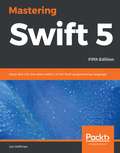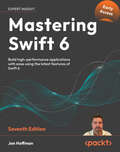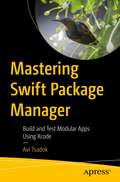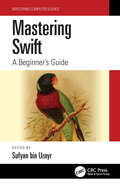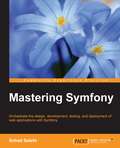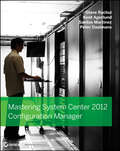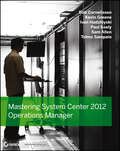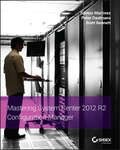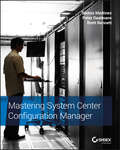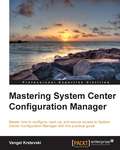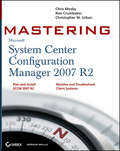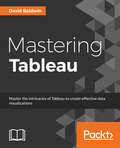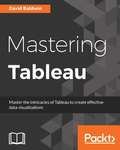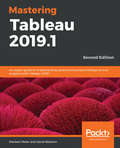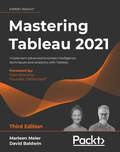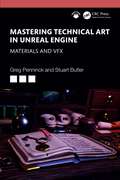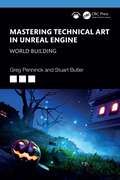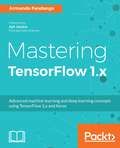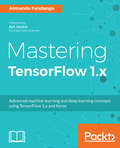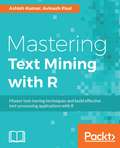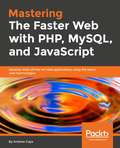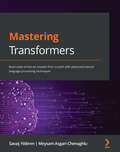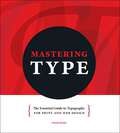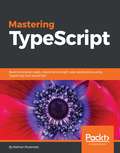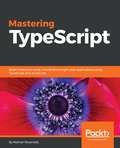- Table View
- List View
Mastering Swift 5: Deep dive into the latest edition of the Swift programming language, 5th Edition
by Jon HoffmanHarness the power of the latest edition with this in-depth and comprehensive guide to the Swift languageKey FeaturesFifth edition of this bestselling book, improved and updated to cover the latest version of the Swift 5 programming languageGet to grips with popular and modern design techniques to write easy-to-manage Swift codeLearn how to use core Swift features such as concurrency, generics, and copy-on-write in your codeBook DescriptionOver the years, the Mastering Swift book has established itself amongst developers as a popular choice as an in-depth and practical guide to the Swift programming language. The latest edition is fully updated and revised to cover the new version: Swift 5.Inside this book, you'll find the key features of Swift 5 easily explained with complete sets of examples. From the basics of the language to popular features such as concurrency, generics, and memory management, this definitive guide will help you develop your expertise and mastery of the Swift language.Mastering Swift 5, Fifth Edition will give you an in-depth knowledge of some of the most sophisticated elements in Swift development, including protocol extensions, error handling, and closures. It will guide you on how to use and apply them in your own projects.Later, you'll see how to leverage the power of protocol-oriented programming to write flexible and easier-to-manage code. You will also see how to add the copy-on-write feature to your custom value types and how to avoid memory management issues caused by strong reference cycles.What you will learnUnderstand core Swift components, including operators, collections, control flows, and functionsLearn how and when to use classes, structures, and enumerationsUnderstand how to use protocol-oriented design with extensions to write easier-to-manage codeUse design patterns with Swift, to solve commonly occurring design problemsImplement copy-on-write for you custom value types to improve performanceAdd concurrency to your applications using Grand Central Dispatch and Operation QueuesImplement generics to write flexible and reusable codeWho this book is forThis book is for developers who want to delve into the newest version of Swift. If you are a developer and learn best by looking at and working with code, then this book is for you. A basic understanding of Apple's tools would be beneficial but not mandatory. All examples should work on the Linux platform as well.
Mastering Swift 6: Build high-performance applications with ease using the latest features of Swift 6
by Jon HoffmanMaster Swift 6 using advanced techniques and modern programming practices to effortlessly build high-performance applications. Purchase of the print or Kindle book includes a free eBook in PDF format.Key FeaturesMaster the new Swift 6 features to enhance your application developmentLearn advanced techniques like concurrency, memory management, and custom operatorsApply best practices in Swift to write clean, scalable, and maintainable codeBook DescriptionMastering Swift 6 is your ultimate guide to harnessing the full power of Swift. Whether you're aiming to optimize the performance of your application or looking to explore the exciting new features in Swift, this book has you covered. With a strong focus on practical applications, you'll dive deep into advanced concepts and techniques, such as concurrency, memory management, and generics, all essential for creating high-performance applications. As you progress through this book, you'll begin by exploring the latest features of Swift 6 before moving on to more advanced topics like advanced operators and error handling. Each chapter builds on the previous one, introducing best practices, testing strategies, and modern programming techniques. By the end, you’ll have a deep understanding of Swift’s complexities, equipping you with the skills to develop scalable, high-performance applications with confidence. Whether you're looking to stay competitive or simply want to excel in Swift 6, this book provides the tools and knowledge you need to succeed.What you will learnImplement the latest Swift 6 features in your applicationsOptimize your application's performance with advanced techniques to meet the demands of the modern userApply best practices for Swift development to write clean and maintainable codeMaster modern programming techniques essential for today's developersConquer advanced topics like concurrency, memory management, and genericsLearn to use result builders and how to create custom operators in SwiftLearn how to effectively test your Swift code for robust applicationsWho this book is forThis book is for developers who have a fundamental grasp of the Swift language and who aspire to take their development skills to the next level by learning some of the advanced topics and techniques of the Swift Language. All examples should be compatible with Linux, in addition to the MacOS, iOS, iPadOS, VisionOS, and WatchOS platforms unless otherwise noted.
Mastering Swift Package Manager: Build and Test Modular Apps Using Xcode
by Avi TsadokMaintaining an iOS project often results in thousands of code files scattered around your folders. Did you ever wanted to reuse those files with other projects but found yourself making copies of Swift files? You are not alone! Many iOS developers struggle with this issue as well—unorganized projects, duplicated files, difficulty in testing, and long complication times. This book will show how Swift Package Manager can help you handle these problems by restructuring your project to make it efficient and straightforward. Swift Package Manager isn’t magic, but you’ll likely need a little guidance in using this nifty tool. You'll see how to reorganize projects smartly and efficiently, create your first Swift package, and learn what libraries are in this context. Then share your package with the rest of your projects. Next test your library’s quality. And then take your library to the next level of power by including files that go beyond just code. By going over the methodology of big project organization, you will have the ability to extend your project into the future as Apple sees it. Make no mistake—the path for a modular and flexible project is not easy. With the help of Swift Package Manager, it becomes possible and worth it. What You'll LearnCreate a Swift package both from the command line and from Xcode Manage Swift packages in public and private Git repositories Build test suites to test integrations between packagesWho This Book Is For Senior iOS developers and team leaders who already have professional experience with Swift.
Mastering Swift: A Beginner's Guide (Mastering Computer Science)
by Sufyan Bin UzayrIf you want to become an iOS developer, you have made an excellent choice with this book. Swift holds a significant position in the iOS industry because of the long list of features it serves. It is user-friendly, has great community support, and offers a greater extent of customization. As a result, we can observe a sharp increase in the market demand for developing Apple mobile applications, and with that, companies search for smart developers with the right skill set. Mastering Swift introduces Apple’s excellent Swift standard library style and incorporates usage feedback across multiple Swift projects. However, it should be regarded as a living, changeable document and the basis upon which the programming language is implemented. Before going further into the details of the Swift programming language, the book briefly explains the basic information about the language. It is a high-level language created to develop multifaceted iOS applications that cater to diverse needs of different social and business domains. It is meant to develop high-end apps with multiple complexities. But since it is very close to Objective C, it is easy to code and understand. This feature also makes it incredibly friendly to beginners. Moreover, it is equally compatible with the iPhone, the iPad, Apple Watch, MacBook, and Apple TV, and it can be applied to develop equally efficient and scalable apps for them. This book in the Mastering series encircles all the essential aspects of Swift and explores why this programming language is the future for iOS app development. Different from other languages, it requires fewer lines to activate any feature. This paves the way for a shorter development cycle and saves a lot of precious resources. Further, as one of the most reliable iOS programming languages it supports dynamic libraries that indicate executable bits of code that you can link to an application. Because of such support, Swift apps can interoperate with the newest version of the language to make the app irreplaceable. Swift is a language that was not designed but deliberately made open source so as to invite community input, allowing the product to grow and to mature over the years. This could possibly be the most crucial aspect of Swift. As people become more aware of its potential to be used in servers, web frameworks were more willing to support the demand. Owing to its popularity and significance, its adoption rate in Apple’s rivals remains very high. Whether you are a beginner or an advanced learner, if you are planning for iOS app development through Swift, this book can help with the high-domain expertise and experienced resources. Without a doubt, the developers that create native apps are not going to abandon Swift anytime soon. However, it seems like something must evolve for it to keep growing constantly. We believe that Swift is indeed the future for iOS app developers. And if you are convinced and want to start learning the programming language right away, then this book is what you’re looking for. Learn more about our other Mastering titles at: https://www.routledge.com/Mastering-Computer-Science/book-series/MCS
Mastering Symfony
by Sohail SalehiOrchestrate the designing, development, testing, and deployment of web applications with Symfony About This Book * Create a robust and reliable Symfony development pipeline using Amazon's cloud platform * Cut development and maintenance costs by defining crystal clear features and possible scenarios for each feature before implementation * Follow detailed examples provided in each chapter to create a task management application Who This Book Is For If you are a PHP developer with some experience in Symfony and are looking to master the framework and use it to its full potential, then this book is for you. Though experience with PHP, object-oriented techniques, and Symfony basics is assumed, this book will give you a crash course on the basics and then proceed to more advanced topics. What You Will Learn * Install and configure Symfony and required third-party bundles to develop a task management application * Set up a continuous integration server to orchestrate automatic builds every time you add a new feature to your project * Reduce maintenance costs dramatically using Behaviour Driven Development (BDD) * Create a slick user interface using the Bootstrap framework * Design robust business logic using Doctrine * Build a comprehensive dashboard and secure your project using the Sonata project * Improve performance using Redis, Memcache, and Varnish * Create customized Symfony commands and add them to your console In Detail In this book, you will learn some lesser known aspects of development with Symfony, and you will see how to use Symfony as a framework to create reliable and effective applications. You might have developed some impressive PHP libraries in other projects, but what is the point when your library is tied to one particular project? With Symfony, you can turn your code into a service and reuse it in other projects. This book starts with Symfony concepts such as bundles, routing, twig, doctrine, and more, taking you through the request/response life cycle. You will then proceed to set up development, test, and deployment environments in AWS. Then you will create reliable projects using Behat and Mink, and design business logic, cover authentication, and authorization steps in a security checking process. You will be walked through concepts such as DependencyInjection, service containers, and services, and go through steps to create customized commands for Symfony's console. Finally, the book covers performance optimization and the use of Varnish and Memcached in our project, and you are treated with the creation of database agnostic bundles and best practices. Style and approach A step-by-step guide to mastering Symfony while developing a task management application. Each chapter comes with detailed examples.
Mastering System Center 2012 Configuration Manager
by Peter Daalmans Kent Agerlund Steve Rachui Santos MartinezExpert coverage of Microsoft's highly anticipated network software deployment toolThe latest version of System Center Configuration Manager (SCCM) is a dramatic update of its predecessor Configuration Manager 2007, and this book offers intermediate-to-advanced coverage of how the new SCCM boasts a simplified hierarchy, role-based security, a new console, flexible application deployment, and mobile management. You'll explore planning and installation, migrating from SCCM 2007, deploying software and operating systems, security, monitoring and troubleshooting, and automating and customizing SCCM 2012 with scripts. Features an unparalleled team of authors, two of whom are insiders at Microsoft and have worked with SCCM since nearly its inceptionProvides in-depth coverage and offers a hands-on approach to learning all there is to know about SCCMExplores why SCCM 2012 is the most significant update in its 16-year historyPacked with real-world scenarios to show you how to use SCCM in various contexts, Mastering System Center Configuration Manager 2012 covers all aspects of this powerful and complete network software deployment tool.
Mastering System Center 2012 Operations Manager
by Telmo Sampaio Bob Cornelissen Kevin Greene Paul Keely Ivan Hadzhiyski Samuel M. AllenAn essential guide on the latest version of Microsoft's server management tool Microsoft's powerful Mastering System Center 2012 Operations Manager introduces many exciting new and enhanced feature sets that allow for large-scale management of mission-critical servers. This comprehensive guide provides invaluable coverage to help organizations monitor their environments across computers, network, and storage infrastructures while maintaining efficient and effective service levels across their applications. Provides intermediate and advanced coverage of all aspects of Systems Center 2012 Operations Manager, including designing, planning, deploying, managing, maintaining, and scripting Operations Manager Offers a hands-on approach by providing many real-world scenarios to show you how to use the tool in various contexts Anchors conceptual explanations in practical application Mastering System Center 2012 Operations Manager clearly shows you how this powerful server management tool can best be used to serve your organization's needs.
Mastering System Center 2012 R2 Configuration Manager
by Peter Daalmans Santos Martinez Brett BennettInvaluable coverage on all aspects of System Center 2012 R2 Configuration ManagerCompletely updated for System Center 2012 R2 Configuration Manager, this comprehensive book provides intermediate and advanced coverage of all aspects of the product, including planning and installation, migrating from previous versions of Configuration Manager, deploying software and operating systems, security, monitoring and troubleshooting, and automating and customizing. Provides numerous real-world scenarios to show you how to use the tool in various contextsExplores planning and installation and migrating from SCCM 2007Walks you through deploying software and operating systems, security, monitoring, and troubleshootingDemonstrates automating and customizing SCCM 2012 with scriptsThis essential book provides you with all the information you need to get savvy with System Center 2012 R2 Configuration Manager.
Mastering System Center Configuration Manager
by Peter Daalmans Santos Martinez Brett BennettGet up to date quickly with clear, expert coverage of SCCM 2016 Mastering System Center Configuration Manager provides comprehensive coverage of Microsoft's powerful network software deployment tool, with a practical hands-on approach. Written by Santos Martinez, Peter Daalmans, and Brett Bennett, this guide walks you through SCCM 2016 with in-depth explanations anchored in real-world applications to get you up to speed quickly. Whether you're planning a new installation or migrating from a previous version of Configuration Manager, this book provides clear instruction and expert insight to get the job done right. Fully aligned with the latest release, the discussion covers the newest tools and features with examples that illustrate utility in a variety of contexts. System Center Configuration Manager (formerly SMS) is one of Microsoft's flagship products; the 2016 release has been updated with better Windows 10 and Windows Server 2016 compatibility, improved tools for managing non-Microsoft mobile devices in the cloud, and more. This book provides start-to-finish coverage and expert guidance on everything you need to get your system up to date. Deploy software and operating systems Automate processes and customize configurations Monitor performance and troubleshoot issues Manage security in the cloud and on Virtual Machines SCCM 2016 improves your ability to handle the bring-your-own-device influx in managing mobile, streamlining the latest hiccup right into the everyday workflow. Mastering System Center Configuration Manager provides the practical coverage you need to get up and running seamlessly.
Mastering System Center Configuration Manager
by Vangel KrstevskiThis book is perfect for IT administrators who are looking to enhance their skills on system and asset management. A fair understanding of the core elements and applications related to SCCM would be helpful.
Mastering System Center Configuration Manager 2007 R2
by Chris Mosby Ron D. Crumbaker Christopher W. UrbanMastering System Center Configuration Manager 2007 provides intermediate and advanced coverage of all aspects of the product, including planning and installation, upgrading Systems Management Server 2003, deploying software and operating systems, security, monitoring and troubleshooting, and automating and customizing SCCM 2007 with scripts.The authors take a hands-on approach by providing many real-world scenarios to show readers how to use the tool in various contexts. This anchors the conceptual explanations in practical application. This book's web site will contain a collection of ready-to-use scripts with directions for implementing them in network systems.
Mastering Tableau
by David BaldwinMaster the intricacies of Tableau to create effective data visualizations About This Book * Arm yourself with an arsenal of advanced chart types and geocoding to efficiently and engagingly present information * Map a grid over a network node diagram and use that grid to demonstrate loads, processing time, and more in Tableau * Integrate R with Tableau by utilizing R functions, libraries, and saved models Who This Book Is For If you are a business analyst without developer-level programming skills, then this book is for you. You are expected to have at least a fundamental understanding of Tableau and basic knowledge of joins, however SQL knowledge is not assumed. You should have basic computer skills, including at least moderate Excel proficiency. What You Will Learn * Create a worksheet that can display the current balance for any given period in time * Recreate a star schema from in a data warehouse in Tableau * Combine level of detail calculations with table calculations, sets, and parameters * Create custom polygons to build filled maps for area codes in the USA * Visualize data using a set of analytical and advanced charting techniques * Know when to use Tableau instead of PowerPoint * Build a dashboard and export it to PowerPoint In Detail Tableau has emerged as one of the most popular Business Intelligence solutions in recent times, thanks to its powerful and interactive data visualization capabilities. This book will empower you to become a master in Tableau by exploiting the many new features introduced in Tableau 10.0. You will embark on this exciting journey by getting to know the valuable methods of utilizing advanced calculations to solve complex problems. These techniques include creative use of different types of calculations such as row-level, aggregate-level, and more. You will discover how almost any data visualization challenge can be met in Tableau by getting a proper understanding of the tool's inner workings and creatively exploring possibilities. You'll be armed with an arsenal of advanced chart types and techniques to enable you to efficiently and engagingly present information to a variety of audiences through the use of clear, efficient, and engaging dashboards. Explanations and examples of efficient and inefficient visualization techniques, well-designed and poorly designed dashboards, and compromise options when Tableau consumers will not embrace data visualization will build on your understanding of Tableau and how to use it efficiently. By the end of the book, you will be equipped with all the information you need to create effective dashboards and data visualization solutions using Tableau. Style and approach This book takes a direct approach, to systematically evolve to more involved functionalities such as advanced calculation, parameters & sets, data blending and R integration. This book will help you gain skill in building visualizations previously beyond your capacity.
Mastering Tableau
by David Baldwin<P><P>Mastering Tableau will help you improve your Tableau skills by providing: <P><P>A quick primer to refresh your skills and ensure a sound foundation <P><P>An understanding of how to effectively structure data for best results in Tableau <P><P>Techniques for using Tableau to explore and cleanse data <P><P>A deep dive into Table calculations and LOD calculations <P><P>Insight on various visualization types, how to build them,and when to use them <P><P>Mapping techniques both native and external to Tableau <P><P>Guidance on effective and advanced dashboarding <P><P>Instruction on using Tableau as an effective presentation tool - with or without PowerPoint <P><P>Techniques for improving performance <P><P>Best practices for interfacing with Tableau Server <P><P>A basic understanding of integrating effectively with R
Mastering Tableau 2019.1: An expert guide to implementing advanced business intelligence and analytics with Tableau 2019.1, 2nd Edition
by David Baldwin Marleen MeierBuild, design and improve advanced business intelligence solutions using Tableau’s latest features, including Tableau Prep, Tableau Hyper, and Tableau ServerKey FeaturesMaster new features in Tableau 2019.1 to solve real-world analytics challengesPerform Geo-Spatial Analytics, Time Series Analysis, and self-service analytics using real-life examplesBuild and publish dashboards and explore storytelling using Python and MATLAB integration supportBook DescriptionTableau is one of the leading business intelligence (BI) tools used to solve BI and analytics challenges. With this book, you will master Tableau's features and offerings in various paradigms of the BI domain. This book is also the second edition of the popular Mastering Tableau series, with new features, examples, and updated code. The book covers essential Tableau concepts and its advanced functionalities. Using Tableau Hyper and Tableau Prep, you’ll be able to handle and prepare data easily. You’ll gear up to perform complex joins, spatial joins, union, and data blending tasks using practical examples. Following this, you’ll learn how to perform data densification to make displaying granular data easier. Next, you’ll explore expert-level examples to help you with advanced calculations, mapping, and visual design using various Tableau extensions. With the help of examples, you’ll also learn about improving dashboard performance, connecting Tableau Server, and understanding data visualizations. In the final chapters, you’ll cover advanced use cases such as Self-Service Analytics, Time Series Analytics, and Geo-Spatial Analytics, and learn to connect Tableau to R, Python, and MATLAB. By the end of this book, you’ll have mastered the advanced offerings of Tableau and be able to tackle common and not-so-common challenges faced in the BI domain.What you will learnGet up to speed with various Tableau componentsMaster data preparation techniques using Tableau PrepDiscover how to use Tableau to create a PowerPoint-like presentationUnderstand different Tableau visualization techniques and dashboard designsInteract with the Tableau server to understand its architecture and functionalitiesStudy advanced visualizations and dashboard creation techniquesBrush up on powerful Self-Service Analytics, Time Series Analytics, and Geo-Spatial AnalyticsWho this book is forThis book is designed for business analysts, BI professionals and data analysts who want to master Tableau to solve a range of data science and business intelligence problems. The book is ideal if you have a good understanding of Tableau and want to take your skills to the next level.
Mastering Tableau 2021: Implement advanced business intelligence techniques and analytics with Tableau, 3rd Edition
by David Baldwin Marleen Meier Kate StrachnyiBuild, design, and improve advanced business intelligence solutions using Tableau's latest features, including Tableau Prep Builder, Tableau Hyper, and Tableau ServerKey FeaturesMaster new features in Tableau 2021 to solve real-world analytics challengesPerform geo-spatial, time series, and self-service analytics using real-life examplesBuild and publish dashboards and explore storytelling using Python and R integration supportBook DescriptionTableau is one of the leading business intelligence (BI) tools used to solve data analysis challenges. With this book, you will master Tableau's features and offerings in various paradigms of the BI domain. Updated with fresh topics including Quick Level of Detail expressions, the newest Tableau Server features, Einstein Discovery, and more, this book covers essential Tableau concepts and advanced functionalities. Leveraging Tableau Hyper files and using Prep Builder, you'll be able to perform data preparation and handling easily. You'll gear up to perform complex joins, spatial joins, unions, and data blending tasks using practical examples. Following this, you'll learn how to execute data densification and further explore expert-level examples to help you with calculations, mapping, and visual design using Tableau extensions. You'll also learn about improving dashboard performance, connecting to Tableau Server and understanding data visualization with examples. Finally, you'll cover advanced use cases such as self-service analysis, time series analysis, and geo-spatial analysis, and connect Tableau to Python and R to implement programming functionalities within Tableau. By the end of this Tableau book, you'll have mastered the advanced offerings of Tableau 2021 and be able to tackle common and advanced challenges in the BI domain.What you will learnGet up to speed with various Tableau componentsMaster data preparation techniques using Tableau Prep BuilderDiscover how to use Tableau to create a PowerPoint-like presentationUnderstand different Tableau visualization techniques and dashboard designsInteract with the Tableau server to understand its architecture and functionalitiesStudy advanced visualizations and dashboard creation techniquesBrush up on powerful self-service analytics, time series analytics, and geo-spatial analyticsWho this book is forThis book is designed for business analysts, business intelligence professionals and data analysts who want to master Tableau to solve a range of data science and business intelligence problems. The book is ideal if you have a good understanding of Tableau and want to take your skills to the next level.
Mastering Technical Art in Unreal Engine: Materials and VFX
by Greg Penninck Stuart ButlerThis book covers how to build materials and VFX that bring your projects to life in Unreal Engine. Each chapter will provide you with the necessary underpinning theory as well as activities to test your learning inside of Unreal Engine.You'll learn about Material Graphs, Parameters, Instances, Materials Maths, Nodes, Niagara Emitters and much more as you complete project-based examples. Included in the book is a series of introductory demonstration videos and quizzes to help test your learning, giving you all the tools and knowledge to make cutting-edge game materials and VFX.This book will be of great interest to all students learning to create technical art within Unreal Engine, as well as professionals looking to sharpen their skills.
Mastering Technical Art in Unreal Engine: World Building
by Stuart Butler Greg PenninckThis covers how to use the latest development tools to create your own Virtual World powered by Unreal Engine. Each chapter will provide you with the necessary underpinning theory as well as activities to test your learning inside of Unreal Engine.You'll learn about Landscapes, Sculpting, Materials, Foliage, Water, Partitions and much more as you complete project-based examples. Included in the book is a series of follow-along introductory videos and quizzes to help test your learning, giving you all the tools and knowledge to make detailed believable worlds in the Unreal Engine.This book will be of great interest to all students learning to create technical art within Unreal Engine, as well as professionals looking to sharpen their skills.
Mastering TensorFlow 1.x: Advanced Machine Learning And Deep Learning Concepts Using Tensorflow 1. X And Keras
by Armando FandangoWe cover advanced deep learning concepts (such as transfer learning, generative adversarial models, and reinforcement learning), and implement them using TensorFlow and Keras. We cover how to build and deploy at scale with distributed models. You will learn to build TensorFlow models using R, Keras, TensorFlow Learn, TensorFlow Slim and Sonnet
Mastering TensorFlow 1.x: Advanced machine learning and deep learning concepts using TensorFlow 1.x and Keras
by Armando Fandango Nick McClureBuild, scale, and deploy deep neural network models using the star libraries in Python Key Features Delve into advanced machine learning and deep learning use cases using Tensorflow and Keras Build, deploy, and scale end-to-end deep neural network models in a production environment Learn to deploy TensorFlow on mobile, and distributed TensorFlow on GPU, Clusters, and Kubernetes Book Description TensorFlow is the most popular numerical computation library built from the ground up for distributed, cloud, and mobile environments. TensorFlow represents the data as tensors and the computation as graphs. This book is a comprehensive guide that lets you explore the advanced features of TensorFlow 1.x. Gain insight into TensorFlow Core, Keras, TF Estimators, TFLearn, TF Slim, Pretty Tensor, and Sonnet. Leverage the power of TensorFlow and Keras to build deep learning models, using concepts such as transfer learning, generative adversarial networks, and deep reinforcement learning. Throughout the book, you will obtain hands-on experience with varied datasets, such as MNIST, CIFAR-10, PTB, text8, and COCO-Images. You will learn the advanced features of TensorFlow1.x, such as distributed TensorFlow with TF Clusters, deploy production models with TensorFlow Serving, and build and deploy TensorFlow models for mobile and embedded devices on Android and iOS platforms. You will see how to call TensorFlow and Keras API within the R statistical software, and learn the required techniques for debugging when the TensorFlow API-based code does not work as expected. The book helps you obtain in-depth knowledge of TensorFlow, making you the go-to person for solving artificial intelligence problems. By the end of this guide, you will have mastered the offerings of TensorFlow and Keras, and gained the skills you need to build smarter, faster, and efficient machine learning and deep learning systems. What you will learn Master advanced concepts of deep learning such as transfer learning, reinforcement learning, generative models and more, using TensorFlow and Keras Perform supervised (classification and regression) and unsupervised (clustering) learning to solve machine learning tasks Build end-to-end deep learning (CNN, RNN, and Autoencoders) models with TensorFlow Scale and deploy production models with distributed and high-performance computing on GPU and clusters Build TensorFlow models to work with multilayer perceptrons using Keras, TFLearn, and R Learn the functionalities of smart apps by building and deploying TensorFlow models on iOS and Android devices Supercharge TensorFlow with distributed training and deployment on Kubernetes and TensorFlow Clusters Who this book is for This book is for data scientists, machine learning engineers, artificial intelligence engineers, and for all TensorFlow users who wish to upgrade their TensorFlow knowledge and work on various machine learning and deep learning problems. If you are looking for an easy-to-follow guide that underlines the intricacies and complex use cases of machine learning, you will find this book extremely useful. Some basic understanding of TensorFlow is required to get the most out of the book.
Mastering Text Mining with R
by Ashish Kumar Avinash PaulMaster text-taming techniques and build effective text-processing applications with R About This Book • Develop all the relevant skills for building text-mining apps with R with this easy-to-follow guide • Gain in-depth understanding of the text mining process with lucid implementation in the R language • Example-rich guide that lets you gain high-quality information from text data Who This Book Is For If you are an R programmer, analyst, or data scientist who wants to gain experience in performing text data mining and analytics with R, then this book is for you. Exposure to working with statistical methods and language processing would be helpful. What You Will Learn • Get acquainted with some of the highly efficient R packages such as OpenNLP and RWeka to perform various steps in the text mining process • Access and manipulate data from different sources such as JSON and HTTP • Process text using regular expressions • Get to know the different approaches of tagging texts, such as POS tagging, to get started with text analysis • Explore different dimensionality reduction techniques, such as Principal Component Analysis (PCA), and understand its implementation in R • Discover the underlying themes or topics that are present in an unstructured collection of documents, using common topic models such as Latent Dirichlet Allocation (LDA) • Build a baseline sentence completing application • Perform entity extraction and named entity recognition using R In Detail Text Mining (or text data mining or text analytics) is the process of extracting useful and high-quality information from text by devising patterns and trends. R provides an extensive ecosystem to mine text through its many frameworks and packages. Starting with basic information about the statistics concepts used in text mining, this book will teach you how to access, cleanse, and process text using the R language and will equip you with the tools and the associated knowledge about different tagging, chunking, and entailment approaches and their usage in natural language processing. Moving on, this book will teach you different dimensionality reduction techniques and their implementation in R. Next, we will cover pattern recognition in text data utilizing classification mechanisms, perform entity recognition, and develop an ontology learning framework. By the end of the book, you will develop a practical application from the concepts learned, and will understand how text mining can be leveraged to analyze the massively available data on social media. Style and approach This book takes a hands-on, example-driven approach to the text mining process with lucid implementation in R.
Mastering The Faster Web with PHP, MySQL, and JavaScript: Develop state-of-the-art web applications using the latest web technologies
by Andrew CayaMake web applications run faster by using advanced PHP, SQL and JavaScript techniquesKey FeaturesUse a customized PHP stack to create efficient data-driven web applicationsEnsure seamless implementation of a JavaScript & HTML 5 CSS based frontend and PHP based backend. Learn about problem identification, best strategies, and UI design patterns as well to build a clean, fast web applicationBook DescriptionThis book will get you started with the latest benchmarking, profiling and monitoring tools for PHP, MySQL and JavaScript using Docker-based technologies. From optimizing PHP 7 code to learning asynchronous programming, from implementing Modern SQL solutions to discovering Functional JavaScript techniques, this book covers all the latest developments in Faster Web technologies. You will not only learn to determine the best optimization strategies, but also how to implement them.Along the way, you will learn how to profile your PHP scripts with Blackfire.io, monitor your Web applications, measure database performance, optimize SQL queries, explore Functional JavaScript, boost Web server performance in general and optimize applications when there is nothing left to optimize by going beyond performance.After reading this book, you will know how to boost the performance of any Web application and make it part of what has come to be known as the Faster Web.What you will learnInstall, confgure, and use profling and benchmarking testing toolsUnderstand how to recognize optimizable data structures and functions to effectively optimize a PHP7 applicationDiagnose bad SQL query performance and discover ways to optimize itGrasp modern SQL techniques to optimize complex SQL queriesIdentify and simplify overly complex JavaScript codeExplore and implement UI design principles that effectively enhance the performanceCombine web technologies to boost web server performanceWho this book is forThe audience for this book would be PHP developers who have some basic knowledge of PHP programming and Web technologies. JavaScript programming knowledge is not necessary.
Mastering Transformers: Build state-of-the-art models from scratch with advanced natural language processing techniques
by Savas Yildirim Meysam Asgari-ChenaghluTake a problem-solving approach to learning all about transformers and get up and running in no time by implementing methodologies that will build the future of NLPKey FeaturesExplore quick prototyping with up-to-date Python libraries to create effective solutions to industrial problemsSolve advanced NLP problems such as named-entity recognition, information extraction, language generation, and conversational AIMonitor your model's performance with the help of BertViz, exBERT, and TensorBoardBook DescriptionTransformer-based language models have dominated natural language processing (NLP) studies and have now become a new paradigm. With this book, you'll learn how to build various transformer-based NLP applications using the Python Transformers library. The book gives you an introduction to Transformers by showing you how to write your first hello-world program. You'll then learn how a tokenizer works and how to train your own tokenizer. As you advance, you'll explore the architecture of autoencoding models, such as BERT, and autoregressive models, such as GPT. You'll see how to train and fine-tune models for a variety of natural language understanding (NLU) and natural language generation (NLG) problems, including text classification, token classification, and text representation. This book also helps you to learn efficient models for challenging problems, such as long-context NLP tasks with limited computational capacity. You'll also work with multilingual and cross-lingual problems, optimize models by monitoring their performance, and discover how to deconstruct these models for interpretability and explainability. Finally, you'll be able to deploy your transformer models in a production environment. By the end of this NLP book, you'll have learned how to use Transformers to solve advanced NLP problems using advanced models.What you will learnExplore state-of-the-art NLP solutions with the Transformers libraryTrain a language model in any language with any transformer architectureFine-tune a pre-trained language model to perform several downstream tasksSelect the right framework for the training, evaluation, and production of an end-to-end solutionGet hands-on experience in using TensorBoard and Weights & BiasesVisualize the internal representation of transformer models for interpretabilityWho this book is forThis book is for deep learning researchers, hands-on NLP practitioners, as well as ML/NLP educators and students who want to start their journey with Transformers. Beginner-level machine learning knowledge and a good command of Python will help you get the best out of this book.
Mastering Type: The Essential Guide to Typography for Print and Web Design
by Denise BoslerGood Design, Down to the LetterPackages on store shelves, posters on building walls, pages of a website-all contain information that needs to be communicated. And at the heart of that communication is type: visually interesting, interactive, expressive and captivating. Each letter must come alive; therefore, each letter must be carefully crafted or chosen. A solid foundation in typography, as well as an understanding of its nuances, will help you optimize your visual communication-in whatever form it takes.By breaking down the study of type into a systematic progression of relationships-letter, word, sentence, paragraph, page and screen-award-winning graphic designer and professor of communication design Denise Bosler provides a unique and illuminating perspective on typography for both print and digital media and for designers of all skill levels.Through instruction, interviews and real-world inspiration, Mastering Type explores the power of each typographic element--both as it stands alone and as it works with other elements--to create successful design, to strengthen your skill set and to inspire your next project.
Mastering TypeScript
by Nathan RozentalsWhether you are a JavaScript developer aiming to learn TypeScript, or an experienced TypeScript developer wanting to take your skills to the next level, this book is for you. From basic to advanced language constructs, test-driven development, and object-oriented techniques, you will learn how to get the most out of the TypeScript language.
Mastering TypeScript
by Nathan Rozentals<P><P>Build enterprise-ready, industrial strength web applications using TypeScript and leading JavaScript frameworks <P><P>Key Features <P><P>Focus on test-driven development to help build quality applications that are modular, scalable, maintainable, and adaptable. <P><P>Practical examples that show you how to use TypeScript with popular JavaScript frameworks including Backbone, Angular, Node.js, require.js, and Marionette <P><P>Enhance your TypeScript knowledge with in-depth discussions on language features, third-party libraries, declaration files, and so on using practical scenarios. <P><P>Book Description <P><P>The TypeScript compiler and language has brought JavaScript development up to the enterprise level, yet still maintains backward compatibility with existing JavaScript browsers and libraries. <P><P>Packed with practical code samples, this book brings the benefits of strongly typed, object-oriented programming and design principles into the JavaScript development space. Starting with core language features, and working through more advanced topics such as generics and modules, you will learn how to gain maximum benefit from your JavaScript development with TypeScript. With a strong focus on test-driven development and coverage of many popular JavaScript frameworks, you can fast-track your TypeScript knowledge to a professional level. By the end of this book, you will be able to confidently implement a TypeScript application from scratch. <P><P>What you will learn <P><P>Gain an insight into core and advanced TypeScript language features including inheritance and generics <P><P>Integrate your existing JavaScript code and third-party JavaScript libraries by writing and using declaration files <P><P>Write TypeScript code to target popular JavaScript frameworks such as jQuery, Backbone, Angular, Node, and Marionette <P><P>Create extensive testing suites for your application, including unit testing, integration testing, and browser automation with Jasmine and Selenium <P><P>Organize your application code using modules, and utilize Asynchronous Module Loading with require.js <P><P>Explore advanced object-oriented techniques including dependency injection and strongly typed domain events <P><P>Build a complete single-page web application with TypeScript and Marionette, incorporating object-oriented design patterns along the way <P><P>Who This Book Is For <P><P>Whether you are a JavaScript developer aiming to learn TypeScript, or an experienced TypeScript developer wanting to take your skills to the next level, this book is for you. From basic to advanced language constructs, test-driven development, and object-oriented techniques, you will learn how to get the most out of the TypeScript language.
